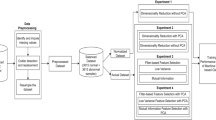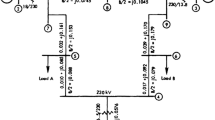Abstract
Electrical power disturbances have negative social, economic, and political impacts. They can lead to catastrophic results that may end with blackouts. Increased understanding, analysis, and prediction of electrical disturbances can help to avoid the occurrence of major disturbances or at least to limit their consequences. This paper develops a system that predicts the type of electrical disturbances using machine learning techniques (MLTs). The proposed system is used for features selection and classification of an open source electrical disturbances dataset available online. Ant colony optimization is used for the features selection and 5 MLTs are adopted for classification; k-nearest neighbor, artificial neural networks, decision tree, logistic regression, and naïve bayes. The findings and results showed that the proposed system has the ability to efficiently classify electrical disturbances with a classification accuracy ranging from 74.57 to 86.11% depending on the classifier used.











Similar content being viewed by others
References
Akaber P, Moussa B, Debbabi M, Assi C (2016) Cascading link failure analysis in interdependent networks for maximal outages in smart grid. In: Smart grid communications (SmartGridComm), 2016 IEEE international conference on, IEEE, Sydney, Australia
Amin M (2004) North American electricity infrastructure: system security, quality, reliability, availability, and efficiency challenges and their societal impacts
Bompard E, Estebsari A, Huang T, Fulli G (2016) A framework for analyzing cascading failure in large interconnected power systems: a post-contingency evolution simulator. Int J Electr Power Energy Syst 81:12–21
Carpaneto E, Chicco G (2008) Distribution system minimum loss reconfiguration in the hyper-cube ant colony optimization framework. Electr Power Syst Res 78(12):2037–2045
Chen J, Thorp J, Parashar M (2001) Analysis of electric power system disturbance data. In: hicss, IEEE, Maui, Hawaii, USA. https://dblp.org/rec/conf/hicss/ChenTP01
Church C, Morsi WG, El-Hawary M, Diduch C, Chang L (2011) Voltage collapse detection using ant colony optimization for smart grid applications. Electr Power Syst Res 81(8):1723–1730
Coello CC, Dehuri S, Ghosh S (2009) Swarm intelligence for multi-objective problems in data mining. Springer, Berlin
Cornforth D (2009a) Applications of data mining to time series of electrical disturbance data. In: Power & energy society general meeting, 2009. PES’09. IEEE, IEEE, Calgary, Alberta, Canada
Cornforth D (2009b) Long tails from the distribution of 23 years of electrical disturbance data. In: Power systems conference and exposition, 2009. PSCE’09. IEEE/PES, IEEE, Calgary, Alberta, Canada
Cornforth D, Nesbitt K (2013) Quality assessment of clusters of electrical disturbances: a case study. In: Industrial electronics and applications (ICIEA), 2013 8th IEEE conference on, IEEE, Melborne, Australia
Dehuri S, Ghosh S, Coello C (2009) An introduction to swarm intelligence for multi-objective problems. In: Swarm Intelligence for multi-objective problems in data mining. Springer, Berlin, Heidelberg, pp 1–17
Dorigo M, Maniezzo V, Colorni A (1996) Ant system: optimization by a colony of cooperating agents. IEEE Trans Syst Man Cybern Part B (Cybern) 26(1):29–41
El Houby EM, Yassin NI, Omran S (2017) A hybrid approach from ant colony optimization and K-nearest neighbor for classifying datasets using selected features. Informatica 41(4):495–506
Freitas AA (2003) A survey of evolutionary algorithms for data mining and knowledge discovery. In: Ghosh A, Tsutsui S (eds) Advances in evolutionary computing. Springer, Berlin, Heidelberg, pp 819–845
Guo H, Zheng C, Iu HH-C, Fernando T (2017) A critical review of cascading failure analysis and modeling of power system. Renew Sustain Energy Rev 80:9–22
Han J, Kamber M, Pei J (2006) Data mining: concept and techniques, 2nd edn. Morgan Kaufman Publisher, San Francisco
Hines P, Apt J, Liao H, Talukdar S (2006) The frequency of large blackouts in the United States electrical transmission system: an empirical study. In: 2nd Carnegie Mellon conference on electric power, January, CiteSeer
Kanan HR, Faez K, Taheri SM (2007) Feature selection using ant colony optimization (ACO): a new method and comparative study in the application of face recognition system. In: Perner P (ed) Advances in data mining. Theoretical aspects and applications. ICDM 2007. Lecture notes in computer science, vol 4597. Springer, Berlin, Heidelberg, pp 63–76
Kira K, Rendell LA (1992) The feature selection problem: traditional methods and a new algorithm. Aaai 2:129–134
Krishnapuram B, Carin L, Figueiredo MA, Hartemink AJ (2005) Sparse multinomial logistic regression: fast algorithms and generalization bounds. IEEE Trans Pattern Anal Mach Intell 27(6):957–968
Leung KM (2007) Naive Bayesian classifier. Polytechnic University Department of Computer Science/Finance and Risk Engineering, New York
Li J, Dueñas-Osorio L, Chen C, Shi C (2017) AC power flow importance measures considering multi-element failures. Reliabil Eng Syst Saf 160:89–97
Liu YY, Yang M, Ramsay M, Li XS, Coid JW (2011) A comparison of logistic regression, classification and regression tree, and neural networks models in predicting violent re-offending. J Quantum Criminol 27(4):547–573
López-Cruz PL, Bielza C, Larrañaga P (2015) Directional naive Bayes classifiers. Pattern Anal Appl 18(2):225–246
Mitzenmacher M, Upfal E (2017) Probability and computing: randomization and probabilistic techniques in algorithms and data analysis. Cambridge University Press, Cambridge
Mousa A, El-Wahed WFA, Rizk-Allah R (2011) A hybrid ant colony optimization approach based local search scheme for multiobjective design optimizations. Electr Power Syst Res 81(4):1014–1023
Nerc D (2001) Review of selected electric system disturbances in North America, 1999 system disturbances. North American Electric Reliability Council, Princeton
Nerc D (2002) Review of selected electric system disturbances in North America, 1996 System Disturbances. North American Electric Reliability Council, Princeton
Nerc D (2004a) Review of selected electric system disturbances in North America, 1997 system disturbances. North American Electric Reliability Council, Princeton
Nerc D (2004b) Review of selected electric system disturbances in North America, 2002 system disturbances. North American Electric Reliability Council, Princeton
Ouyang M (2013) Comparisons of purely topological model, betweenness based model and direct current power flow model to analyze power grid vulnerability. Chaos Interdiscip J Nonlinear Sci 23(2):023114
Rosario SF, Thangadurai K (2015) RELIEF: feature selection approach. Int J Innov Res Dev 4(11):218–224 (ISSN 2278–0211)
Simonoff JS, Restrepo CE, Zimmerman R (2007) Risk-management and risk-analysis-based decision tools for attacks on electric power. Risk Anal 27(3):547–570
Tabakhi S, Moradi P, Akhlaghian F (2014) An unsupervised feature selection algorithm based on ant colony optimization. Eng Appl Artif Intell 32:112–123
Talukdar SN, Apt J, Ilic M, Lave LB, Morgan MG (2003) Cascading failures: survival versus prevention. Electr J 16(9):25–31
Veloza OP, Santamaria F (2016) Analysis of major blackouts from 2003 to 2015: classification of incidents and review of main causes. Electr J 29(7):42–49
Warnier M, Dulman S, Koç Y, Pauwels E (2017) Distributed monitoring for the prevention of cascading failures in operational power grids. Int J Crit Infrastruct Prot 17:15–27
Wu X, Kumar V, Quinlan JR, Ghosh J, Yang Q, Motoda H, McLachlan GJ, Ng A, Liu B, Philip SY (2008) Top 10 algorithms in data mining. Knowl Inf Syst 14(1):1–37
Xue F, Bompard E, Huang T, Jiang L, Lu S, Zhu H (2017) Interrelation of structure and operational states in cascading failure of overloading lines in power grids. Phys A 482:728–740
Acknowledgements
The authors would like to thank Professor David Cornforth of the School of Electrical Engineering and Computing, University of Newcastle, Australia for his guidance and support to this research work.
Author information
Authors and Affiliations
Corresponding author
Ethics declarations
Conflict of interest
The authors declare that they have no conflict of interest.
Additional information
Publisher's Note
Springer Nature remains neutral with regard to jurisdictional claims in published maps and institutional affiliations.
Rights and permissions
About this article
Cite this article
Omran, S., El Houby, E.M.F. Prediction of electrical power disturbances using machine learning techniques. J Ambient Intell Human Comput 11, 2987–3003 (2020). https://doi.org/10.1007/s12652-019-01440-w
Received:
Accepted:
Published:
Issue Date:
DOI: https://doi.org/10.1007/s12652-019-01440-w




